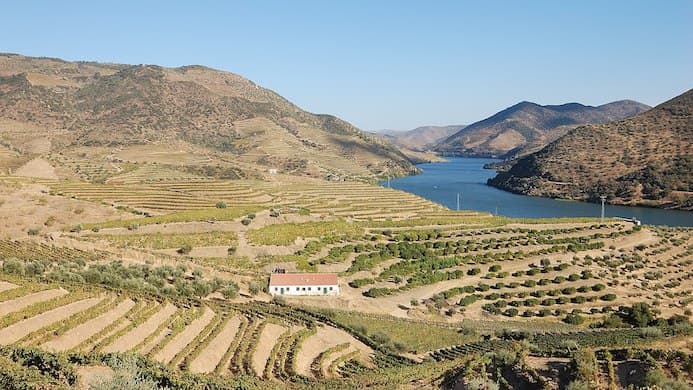Maybe You Can Teach an Old Dog New Tricks — in the Wine World, at Least
An emerging group of vignerons is breaking the 400-year-old Port industry and creating something new. They’ve borrowed concepts from around the world to craft some of Portugal’s most thrilling and delicious wines.

Port deserves a place in your glass, but all week I’ve been thinking about the “New Douro.” This emerging group of vignerons is breaking the 400-year-old industry and creating something new. They’ve borrowed concepts from around the world, funneled through a Portuguese lens, to craft some of the country’s most thrilling, elegant, and delicious wines.
Why now? Because, why rock the boat when so much money is to be made? For centuries, the Port industry’s success meant it had total control over the fortunes of the Douro Valley: thousands of small subsistence farmers and its wines. There was no need to alter farming methods, or to literally dig deeper into the soils to understand them better, or to make wines of any other style.
The turbulence of the last century — two world wars, Salazar, technological advancements (electricity came in the 1960s), and changing global tastes — meant the boat had nearly capsized. Port houses have attempted adaptation; one method is adding still wines to their line ups.
Change is difficult. Their biggest challenges are raw materials and production methods. Grapes farmed to make excellent Port — very ripe, with lots of sugar, lower acidity, and very high tannin — are not the ideal for producing excellent still wines. Neither are fast, hot fermentations often the path to layered, complex, elegant bottles.
What makes a great still wine? Many would say terroir, the concept of a food or drink reflecting the place it’s from. This isn’t just about a grape vine being grown in a corresponding climate and soil (though that’s a major factor): In its broadest sense, it also means the cultural and historical effects, both advantages and constraints, placed on vignerons and their adaptation to them, which help create the unique traditions of winemaking in each specific place.
Many pushed ahead, without much understanding of these differences. Most (with some notable exceptions) tended to be clunky, heavy, harshly tannic, overly fruity, often jammy, one-dimensional offerings. That kind of wine is acceptable as an inexpensive liquid chocolate replacement, but not on par quality- or price-wise with their greatest Ports.
They needed to understand their terroir through a whole new scope. Two people have taken on this monumental task: Mateus Nicolau de Almeida and Luis Seabra. In less than 20 years, separately, they’ve managed to extract the knowledge and understanding out of the Douro Valley necessary to make absolutely brilliant wines.
The Almeida family has deep roots in the valley. They used to own and still make the Port for Ramos Pintos, and Mateus’s grandfather made Barca Velha, one of the few exceptional dry wines to be found before this decade. Mateus and his sister, Maflada, started exploring the terroir of the entire valley and farming for still wines.
Douro Valley is divided into three regions: To the west is Baixo Corgo, the coldest and wettest section, thanks to the influence from the Atlantic Ocean just over the mountains from Oporto. These grapes were low quality for Port production, used for bulk wine or blended better wines for their acidity.
In the middle is Cima Corgo, more Mediterranean and moderate in climate. And to the east is Douro Superior, purely continental, hot, and dry, and where all the greatest vintage Port grapes are sourced.
For his red wines, Mateus expressed his findings through different vineyards in each zone. He used traditional field blends, converted to organic and biodynamic methods, and farmed with the intention of making dry still wines. Each is a reflection of a different climate, all made with the same artisanship, the same quality, leaving the drinker to choose a preferred style, from light and elegant to concentrated and powerful.
White wines, on the other hand, are from the same vineyard in Douro Superior, but from three distinct plots. The noble Rabigato grape is able to clearly distinguish the subtle nuances in the schist soils in each plot.
Luis Seabra has garnered even more international recognition for his project. His family is from the valley, but he was born in Angola and moved there later. He started winemaking in Vinho Verde, the region just to the north of Douro, where he began his study of soil.
Then he moved onto working at Niepoort Vinhos, a rare Portuguese-owned Port house established in 1842. Under Dirk Niepoort, a renowned philosophizing, terroir-chasing innovator in his own right, he got the opportunity to launch a still wine program back in 2004. Dirk offered him mentorship and allowed the freedom to garner a deeper understanding of his surroundings.
Nearly a decade later, Luis launched his own brand. Most are made in the Douro Valley, but he’s also launched projects, either renting or buying vineyards in Vinho Verde and Dão, to have a broader understanding of Portugal’s unique wine regions. The wines take the best traditions of the country — its climate, soils, grapes, and old-vine vineyards — and overlay some of Europe’s fine-wine techniques.
Fermentations are spontaneous and entirely in used wood barrels, of varying sizes, as oxygen regulators depending on the tannins of the berries. Macerations of the most tannic can last up to two months, like the great Nebbiolos of Piedmont, allowing them to form long chains, and melt away. Whole bunches in the red wines are used in varying degrees for structure and aromatics. Temperature is controlled when necessary. Aging and maturing is done in mixed containers, for extended periods of time. The methods are minimal, the results are balanced.
His lineup is a mish-mash of European sentiments. The “Cru” series are single terroirs while the “Ilimitado” are village wines, blending grapes from across a wider region, based off of the Burgundian quality pyramid. Some are blends of varieties, if that is traditional in a particular area, like Encruzado, Bical, and Sercial in Granito Cru Dão Branco, a single vineyard white from the Dão region. Others are focused on single varieties, like the incredible Granito Cru Alvarinho, which I liken to the Corton of Portugal.
Luis’s accolades and attention are well deserved, as his wines are not just the best in Portugal but on par with the great wines of the world, in relation to their finesse and terroir specificity.
Both he and Mateus Nicolau de Almeida are changing the perception of Douro and Portuguese wines. They are joined with other forward-thinking winemakers across the country. There is a rediscovery of lost regions, ancient vineyards, nearly extinct grapes, and a bringing of them to light in our modern age. Tradition will always have a place in Portugal and wine, but its best wines are being made now.

